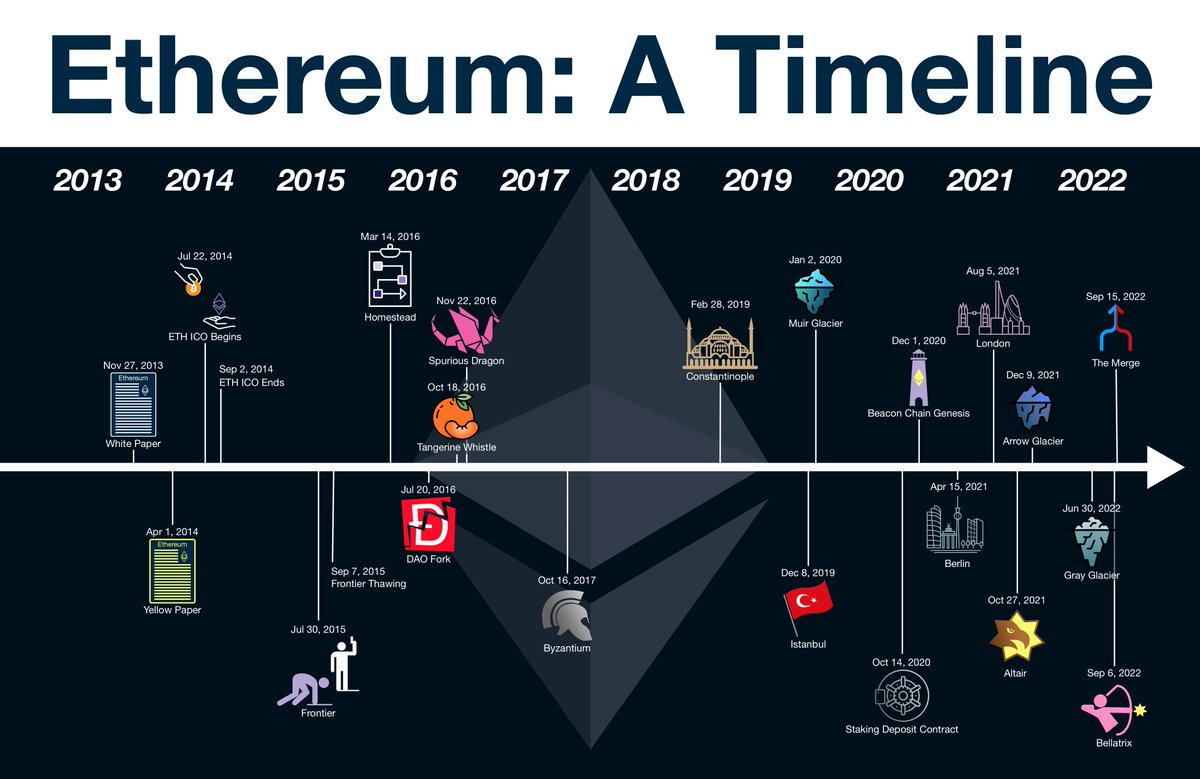
It's 2022, by now you should know Ethereum as the World Computer.
But Ethereum wasn't always the sophisticated, modular blockchain we know today; in fact, in many ways it's unrecognizable from its origins.
The true genesis of Ethereum was in 2008, when Satoshi Nakamoto released the Bitcoin whitepaper and hinted at trustless computing.
Vitalik can bring you from 2008 until we begin. The "pre-history of Ethereum."
¶ Ethereum White Paper
¶ November 27, 2013
Vitalik publishes "Ethereum: A Next-Generation Smart Contract and Decentralized Application Platform," the original Ethereum whitepaper.
¶ Ethereum Yellow Paper
¶ April 1st, 2014
Gavin Wood publishes the original Ethereum yellowpaper, the (more) technical specifications of the protocol.
¶ ETH ICO
¶ July 22nd, 2014
For 42 days in 2014, you can participate in Ethereum's Initial Coin Offering (ICO). At the end, ETH is worth ~$0.30.
¶ Ethereum Launch - Frontier
¶ July 30th, 2015
Frontier is the first (barebones) implementation of Ethereum. A "thawing" period allows technical users to begin operations early.
¶ Homestead
¶ March 14th, 2016
The Homestead hard fork implements several protocol and networking changes that would make it more upgradable in the future.
¶ The DAO
¶ July 20th, 2016
The DAO, its hack and the resulting hard fork is one of the most incredible and important of the early days of Ethereum. I highly recommend reading more.
Fun fact: the chain that continued on and did not fork? You know it as Ethereum Classic (ETC)
¶ Shanghai Attacks
¶ September 2016
Shortly after the DAO hack was resolved, Ethereum faces another existential attack. In September 2016, an attacker unleashes a DDOS attack, freezing Ethereum and threatening the protocol.
¶ Tangerine Whistle
¶ October 18th, 2016
The 1st response to the DDOS attacks is released (Tangerine Whistle).
¶ Spurious Dragon
¶ November 22nd, 2016
The 2nd response to the DDOS attacks is released (Spurious Dragon), ending the attack.
¶ Byzantium
¶ October 16th, 2017
The Byzantium hard fork is the first of a two phase upgrade to Ethereum 's privacy, scalability and security. Byzantium makes Ethereum lighter/faster to run.
¶ Constantinople
¶ February 28th, 2019
Constantinople is the second phase of the upgrade, further improving performance and begins to lay the infrastructure for Proof of Stake.
¶ Istanbul
¶ December 8th, 2019
Istanbul introduces more privacy and scaling capabilities, targeting the performance of ZK SNARKs and STARKs. It also has a overhaul to the gas market.
¶ Glacier
¶ January 2nd, 2020
The glacier hard forks are simple changes to Ethereum: they delay the difficultly bomb. Difficultly is the metric that controls the viability of PoW.
¶ Staking Deposit Contract
¶ October 14th, 2020
The Ethereum staking deposit contract launches, ~1.5 months before the Beacon Chain launches. Users deposit ETH, waiting to participate in ETH PoS.
¶ Beacon Chain Launches
¶ December 1st, 2020
After the staking contract gathered enough ETH, the Beacon Chain launches. Eventually, this Proof of (ETH) Stake chain will merge with Ethereum.
¶ Berlin
¶ April 15th, 2021
Berlin changes gas prices and allows new transaction types. This upgrade is a stepping stone to the much larger London hard fork.
¶ London
¶ August 5th, 2021
London is headlined by EIP-1559, which radically overhauls the gas market and introduces a base fee (gas fee that will be burnt).
¶ Altair
¶ October 27th, 2021
Altair is the first upgrade to the Beacon Chain, adding support for sync committees and moving Ethereum closer to its goal of enabling light clients.
¶ Arrow Glacier
¶ December 9th, 2021
The glacier hard forks are simple changes to Ethereum: they delay the difficultly bomb. Difficultly is the metric that controls the viability of PoW.
¶ Gray Glacier
¶ June 30th, 2022
The glacier hard forks are simple changes to Ethereum: they delay the difficultly bomb. Difficultly is the metric that controls the viability of PoW.
¶ Bellatrix
¶ September 6th, 2022
Bellatrix is the 2nd/final upgrade to the Beacon Chain, preparing it to Merge with Ethereum. Bellatrix fully enables validator penalties, sets fork choice rules and sets the terminal total difficulty.
¶ The Merge
¶ September 15th, 2022
One week after Bellatrix set the stage, the Beacon Chain and the Proof of Work chain Merge to become Ethereum, the World Computer.
¶ Today
Today Ethereum has Merged and is the worlds largest, most secure, most advanced blockchain.
Just as the globe is calling for credible neutrality, the World Computer is coming online.
¶ Resources
Source Material - Twitter Link